Solutions For All Chapters Science Class 9
Questions From NCERT Textbook
Question 1: An athlete completes one round of a circular track of diameter 200 m in 40 s. What will be the distance covered and the displacement at the end of 2 minutes 20 s?
ANSWER: Diameter of a circular track, d = 200 m
Radius of the track, r =
Circumference = 2πr = 2π (100) = 200π m
In 40 s, the given athlete covers a distance of 200π m.
In 1 s, the given athlete covers a distance =
The athlete runs for 2 minutes 20 s = 140 s
∴Total distance covered in
The athlete covers one round of the circular track in 40 s. This means that after every 40 s, the athlete comes back to his original position. Hence, in 140 s he had completed 3 rounds of the circular track and is taking the fourth round.
He takes 3 rounds in 40 × 3 = 120 s. Thus, after 120 s his displacement is zero.
Then, the net displacement of the athlete is in 20 s only. In this interval of time, he moves at the opposite end of the initial position. Since displacement is equal to the shortest distance between the initial and final position of the athlete, displacement of the athlete will be equal to the diameter of the circular track.
∴ Displacement of the athlete = 200 m
Distance covered by the athlete in 2 min 20 s is 2200 m and his displacement is
200 m.
Question 2: Joseph jogs from one end A to the other end B of a straight 300 m road in 2 minutes 30 seconds and then turns around and jogs 100 m back to point C in another 1 minute. What are Joseph’s average speeds and velocities in jogging (a) from A to B and (b) from A to C?
ANSWER:
(a) 2 m/s, 2 m/s (b) 1.90 m/s, 0.95 m/s
(a) From end A to end B
Distance covered by Joseph while jogging from A to B = 300 m
Time taken to cover that distance = 2 min 30 seconds = 150 s
Total distance covered = 300 m
Total time taken = 150 s
Average speed = 300/150 = 2 m/s
Displacement = shortest distance between A and B = 300 m
Time interval = 150 s
Average velocity = 300/150 = 2 m/s
The average speed and average velocity of Joseph from A to B are the same and equal to 2 m/s.
(b) From end A to end C
Total distance covered = Distance from A to B + Distance from B to C
= 300 + 100 = 400 m
Total time taken = Time taken to travel from A to B + Time taken to travel from B to C = 150 + 60 = 210 s
Average speed = 400/210 = 1.90 m/s
Displacement from A to C = AC = AB − BC = 300 − 100 = 200 m
Time interval = time taken to travel from A to B + time taken to travel from B to C
= 150 + 60 = 210 s
Average velocity = 200/210 = 0.95 m/s
The average speed of Joseph from A to C is 1.90 m/s and his average velocity is 0.95 m/s.
Question 3: Abdul, while driving to school, computes the average speed for his trip to be 20 km h−1. On his return trip along the same route, there is less traffic and the average speed is 30 km h−1. What is the average speed for Abdul’s trip?
ANSWER:
Case I: While driving to school
Average speed of Abdul’s trip = 20 km/h
Case II: While returning from school
Question 4: A motorboat starting from rest on a lake accelerates in a straight line at a constant rate of 3.0 m s−2 for 8.0 s. How far does the boat travel during this time?
ANSWER: Initial velocity, u = 0 (since the motor boat is initially at rest)
Acceleration of the motorboat, a = 3 m/s2
Hence, the boat travels a distance of 96 m.
5. A driver of a car travelling at 52 km h–1 applies the brakes Shade the area on the graph that represents the distance travelled by the car during the period.
(b) Which part of the graph represents uniform motion of the car?
ANSWER: Shade the area on the graph that represents the distance travelled by the car during the period.
On a velocity-time graph, the area under the curve represents the distance travelled by the car during that time.
When brakes are applied, the velocity decreases from 52 km/h to 0 (assuming car comes to rest).
On the graph (not shown here), shade the area below the velocity-time line (which may be a sloped line from 52 km/h to 0) and above the time axis. This area gives the total distance travelled while coming to rest.
If the braking is uniform, the area will be a triangle:
Initial velocity, u = 52 km/h = \(\frac{52\times 1000}{60\times 60}\) =14.44 m/s
If the car comes to rest in time t, area = \(\frac{1}{2}\)×base×height = \(\frac{1}{2}\)×t×14.44
– Shade this triangular area in the graph.
b) Which part of the graph represents uniform motion of the car?
On a distance-time graph, uniform motion is represented by a straight line with constant slope (not curved).
On a velocity-time graph, it is represented by a horizontal straight line (velocity is constant with respect to time).
The segment before brakes are applied, where velocity remains at 52 km/h, is uniform motion.
Question 6: Fig 7.10 shows the distance-time graph of three objects A, B and C. Study the graph and answer the following questions:
(a) Which of the three is travelling the fastest?
(b) Are all three ever at the same point on the road?
(c) How far has C travelled when B passes A?
(d)How far has B travelled by the time it passes C?
ANSWER:
(a)Object B
(b)No
(c)5.714 km
(d)5.143 km
∴Speed = slope of the graph
Since slope of object B is greater than objects A and C, it is travelling the fastest.
(b) All three objects A, B and C never meet at a single point. Thus, they were never at the same point on road.
(C)
Hence, C has travelled a distance of 5.714 km when B passes A.
(d)
Distance covered by B at the time it passes C = 9 boxes
Hence, B has travelled a distance of 5.143 km when B passes A.
Question 7: A ball is gently dropped from a height of 20 m. If its velocity increases uniformly at the rate of 10 m/s2, with what velocity will it strike the ground? After what time will it strike the ground?
ANSWER: Distance covered by the ball, s = 20 m
Hence, the ball strikes the ground after 2 s with a velocity of 20 m/s.
Question 8: The speed-time graph for a car is shown is Fig. 7.11.
Fig.7.11
(a) Find out how far the car travels in the first 4 seconds. Shade the area on the graph that represents the distance travelled by the car during the period.
(b) Which part of the graph represents uniform motion of the car?
ANSWER:
(a)
(b)
The part of the graph in red colour between time 6 s to 10 s represents uniform motion of the car.
Question 9: State which of the following situations are possible and give an example for each of these:
(a) an object with a constant acceleration but with zero velocity.
(c) an object moving in a certain direction with an acceleration in the perpendicular direction.
ANSWER:
(a) Possible
When a ball is thrown up at maximum height, it has zero velocity, although it will have constant acceleration due to gravity, which is equal to 9.8 m/s2.
(c) Possible
When a car is moving in a circular track, its acceleration is perpendicular to its direction.
Question 10: An artificial satellite is moving in a circular orbit of radius 42250 km. Calculate its speed if it takes 24 hours to revolve around the earth.
ANSWER:
Hence, the speed of the artificial satellite is 3.069 km/s.
NCERT Textbook for Class 9 Science – Page 74
Question 1: An object has moved through a distance. Can it have zero displacement? If yes, support your answer with an example.
ANSWER: Yes. An object that has moved through a distance can have zero displacement. Displacement is the shortest measurable distance between the initial and the final position of an object. An object which has covered a distance can have zero displacement, if it comes back to its starting point, i.e., the initial position.
Consider the following situation. A man is walking in a square park of length 20 m (as shown in the following figure). He starts walking from point A and after moving along all the corners of the park (point B, C, D), he again comes back to the same point, i.e., A.
In this case, the total distance covered by the man is 20 m + 20 m + 20 m
+ 20 m = 80 m. However, his displacement is zero because the shortest distance between his initial and final position is zero.
Question 2: A farmer moves along the boundary of a square field of side 10 m in 40 s. What will be the magnitude of displacement of the farmer at the end of 2 minutes 20 seconds from his initial position?
ANSWER:
rounds (3 complete rounds and a half round) of the field in 2 min and 20 s.
That means, after 2 min 20 s, the farmer will be at the opposite end of the starting point.
Now, there can be two extreme cases.
Case I: Starting point is a corner point of the field.
In this case, the farmer will be at the diagonally opposite corner of the field after 2 min 20 s.
Therefore, the displacement will be equal to the diagonal of the field.
Hence, the displacement will be
Case II: Starting point is the middle point of any side of the field.
In this case the farmer will be at the middle point of the opposite side of the field after 2 min 20 s.
Therefore, the displacement will be equal to the side of the field, i.e., 10 m.
For any other starting point, the displacement will be between 14.1 m and 10 m.
Question 3: Which of the following is true for displacement?
(a) It cannot be zero.
(b) Its magnitude is greater than the distance travelled by the object.
ANSWER:
(a) Not true
Displacement can become zero when the initial and final position of the object is the same.
(b) Not true
Displacement is the shortest measurable distance between the initial and final positions of an object. It cannot be greater than the magnitude of the distance travelled by an object. However, sometimes, it may be equal to the distance travelled by the object.
NCERT Textbook for Class 9 Science – Page 76
Question 1: Distinguish between speed and velocity.
ANSWER:
Speed | Velocity |
| Speed is the distance travelled by an object in a given interval of time. It does not have any direction. | Velocity is the displacement of an object in a given interval of time. It has a unique direction. |
| Speed is given by the relation: | Velocity is given by the relation: |
| The speed of an object can never be negative. At the most, it can become zero. This is because distance travelled can never be negative. | The velocity of an object can be negative, positive, or equal to zero. This is because displacement can take any of these three values. |
Question 2: Under what condition(s) is the magnitude of average velocity of an object equal to its average speed?
ANSWER:
If the total distance covered by an object is the same as its displacement, then its average speed would be equal to its average velocity.
Question 3: What does the odometer of an automobile measure?
ANSWER: The odometer of an automobile measures the distance covered by an automobile.
Question 4: What does the path of an object look like when it is in uniform motion?
ANSWER: An object having uniform motion has a straight line path.
5. During an experiment, a signal from a spaceship reached the ground station in five minutes. What was the distance of the spaceship from the ground station? The signal travels at the speed of light, that is, 3 × 108 m s–1.
ANSWER: Given:
Speed of signal (v) = 3 × 10⁸ m/s
Time taken (t) = 5 minutes = 5 × 60 = 300 s
Distance (s) = v × t
= 3 × 10⁸ × 300
= 9 × 10¹⁰ m
NCERT Textbook for Class 9 Science – Page 77
Question 1: When will you say a body is in (i) uniform acceleration? (ii) non-uniform acceleration?
ANSWER:
(i) A body is said to have uniform acceleration if it travels in a straight path in such a way that its velocity changes at a uniform rate, i.e., the velocity of a body increases or decreases by equal amounts in an equal interval of time.
(ii) A body is said to have non-uniform acceleration if it travels in a straight path in such a way that its velocity changes at a non-uniform rate, i.e., the velocity of a body increases or decreases in unequal amounts in an equal interval of time.
Question 2: A bus decreases its speed from 80 km h−1 to 60 km h−1 in 5 s. Find the acceleration of the bus.
Here, the negative sign of acceleration indicates that the velocity of the car is decreasing.
NCERT Textbook for Class 9 Science – Page 81
Question 1: What is the nature of the distance−time graphs for uniform and non-uniform motion of an object?
ANSWER: The distance−time graph for uniform motion of an object is a straight line (as shown in the following figure).
The distance−time graph for non-uniform motion of an object is a curved line (as shown in the given figure).
Question 2: What can you say about the motion of an object whose distance−time graph is a straight line parallel to the time axis?
ANSWER: When an object is at rest, its distance−time graph is a straight line parallel to the time axis.
A straight line parallel to the x-axis in a distance−-time graph indicates that with a change in time, there is no change in the position of the object. Thus, the object is at rest.
Question 3: What can you say about the motion of an object if its speed−time graph is a straight line parallel to the time axis?
ANSWER: Object is moving uniformly.
A straight line parallel to the time axis in a speed−time graph indicates that with a change in time, there is no change in the speed of the object. This indicates the uniform motion of the object.
Question 4: What is the quantity which is measured by the area occupied below the velocity−time graph?
ANSWER: Distance
The graph shows the velocity−time graph of a uniformly moving body.
Let the velocity of the body at time (t) be v.
Area of the shaded region = length × breath
Where,
Length = t
Breath = v
Area = vt = velocity × time …(i)
We know,
Velocity = Displacement/TIme
∴ Displacement = Velocity × Time…(ii)
From equations (i) and (ii),
Area = Displacement
Hence, the area occupied below the velocity−time graph measures the displacement covered by the body.
NCERT Textbook for Class 9 Science – Page 82
Question 1: A bus starting from rest moves with a uniform acceleration of 0.1 m s−2 for 2 minutes. Find (a) the speed acquired, (b) the distance travelled.
ANSWER:
(a) 12 m/s (b) 720 m
(a) Initial speed of the bus, u = 0 (since the bus is initially at rest)
Acceleration, a = 0.1 m/s2
Time taken, t = 2 minutes = 120 s
Let v be the final speed acquired by the bus.
∴v = 12 m/s
(b) According to the third equation of motion:
v2 − u2 = 2as
Where, s is the distance covered by the bus
(12)2 − (0)2 = 2(0.1) s
s = 720 m
Speed acquired by the bus is 12 m/s.
Distance travelled by the bus is 720 m.
Question 2: A train is travelling at a speed of 90 km h−1. Brakes are applied so as to produce a uniform acceleration of −0.5 m s−2. Find how far the train will go before it is brought to rest.
ANSWER:
Initial speed of the train, u = 90 km/h = 25 m/s
Final speed of the train, v = 0 (finally the train comes to rest)
Acceleration = −0.5 m s−2
According to third equation of motion:
v2 = u2 + 2 as
(0)2 = (25)2 + 2 (−0.5) s
Where, s is the distance covered by the train
The train will cover a distance of 625 m before it comes to rest.
Question 3: A trolley, while going down an inclined plane, has an acceleration of 2 cm s−2. What will be its velocity 3 s after the start?
ANSWER:
Initial velocity of the trolley, u = 0 (since the trolley was initially at rest)
Acceleration, a = 2 cm s−2 = 0.02 m/s2
Time, t = 3 s
According to the first equation of motion:
v = u + at
Where, v is the velocity of the trolley after 3 s from start
v = 0 + 0.02 × 3 = 0.06 m/s
Hence, the velocity of the trolley after 3 s from start is 0.06 m/s.
Question 4: A racing car has a uniform acceleration of 4 m s−2. What distance will it cover in 10 s after start?
ANSWER:
Initial velocity of the racing car, u = 0 (since the racing car is initially at rest)
Acceleration, a = 4 m/s2
Time taken, t = 10 s
According to the second equation of motion:
Where, s is the distance covered by the racing car
Hence, the distance covered by the racing car after 10 s from start is 200 m.
Question 5: A stone is thrown in a vertically upward direction with a velocity of 5 m s−1. If the acceleration of the stone during its motion is 10 m s−2 in the downward direction, what will be the height attained by the stone and how much time will it take to reach there?
ANSWER:
Initially, velocity of the stone,u = 5 m/s
Final velocity, v = 0 (since the stone comes to rest when it reaches its maximum height)
Acceleration of the stone, a = acceleration due to gravity, g = 10 m/s2
(in downward direction)
There will be a change in the sign of acceleration because the stone is being thrown upwards.
Acceleration, a = −10 m/s2
Let s be the maximum height attained by the stone in time t.
According to the first equation of motion:
v = u + at
0 = 5 + (−10) t
According to the third equation of motion:
v2 = u2 + 2 as
(0)2 = (5)2 + 2(−10) s
Hence, the stone attains a height of 1.25 m in 0.5 s.




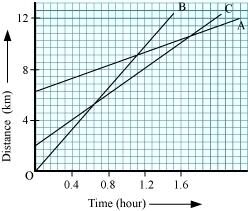
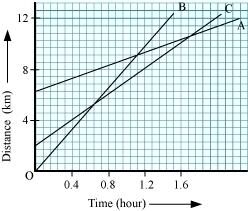
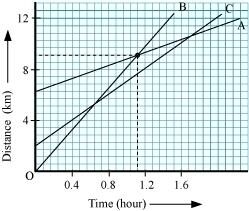

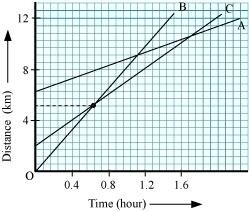

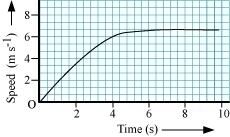
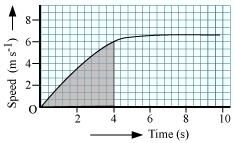

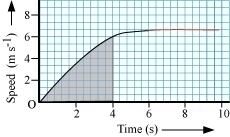






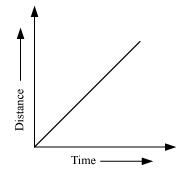
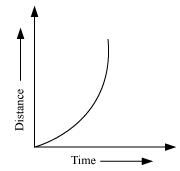
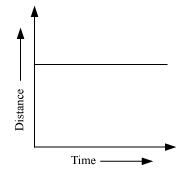
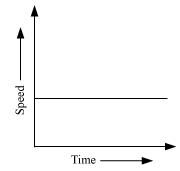
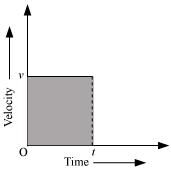


Leave a Reply